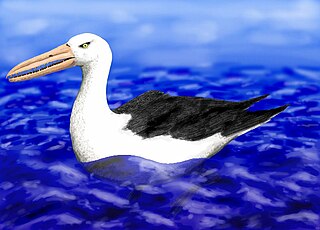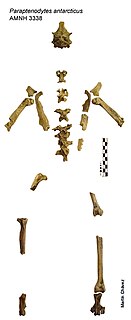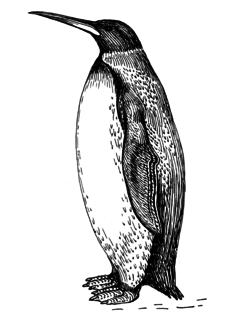
The laughing owl, also known as whēkau or the white-faced owl, was an endemic owl of New Zealand. Plentiful when European settlers arrived in New Zealand, its scientific description was published in 1845, but it was largely or completely extinct by 1914. The species was traditionally considered to belong to the monotypic genus SceloglauxKaup, 1848, although recent genetic studies indicate that it belongs with the boobook owls in the genus Ninox.
Korora oliveri, also referred to as Oliver's penguin, is a genus and species of extinct penguin from the Waitakian Stage of New Zealand. It was relatively small and slender, similar in size to one of the larger crested penguins. The penguin was described by Brian Marples in 1952 from fossil material he collected in the Hakataramea Valley, in the Canterbury region of the South Island. The genus name Korora is the Māori term for the extant little penguin. The specific epithet honours Walter Oliver (1883–1957) a former director of the Dominion Museum.

Osteodontornis is an extinct seabird genus. It contains a single named species, Osteodontornis orri, which was described quite exactly one century after the first species of the Pelagornithidae was. O. orri was named after then-recently deceased naturalist Ellison Orr.
Archaeospheniscus is an extinct genus of large penguins. It currently contains three species, known from somewhat fragmentary remains. A. wimani, the smallest species, was found in Middle or Late Eocene strata of the La Meseta Formation on Seymour Island, Antarctica, whereas the other two, about the size of a modern emperor penguin, are known from bones recovered from the Late Oligocene Kokoamu Greensand Formation at Duntroon, New Zealand.

Palaeeudyptes is an extinct genus of large penguins, currently containing four accepted species. They were probably larger than almost all living penguins, with the smaller species being about the size of an emperor penguin, and the largest species, Palaeeudyptes klekowskii, having stood up to 2 meters (6.6 ft) tall and weighed up to 116 kg (256 lb).

Paraptenodytes is an extinct genus of penguins which contains two or three species sized between a Magellanic penguin and an emperor penguin. They are known from fossil bones ranging from a partial skeleton and some additional material in the case of P. antarcticus, the type specimen for the genus, and a single humerus in the case of P. brodkorbi. The latter species is therefore often considered invalid; a recent study considers it indeed valid, but distinct enough not to belong into Paraptenodytes. The fossils were found in the Santa Cruz and Chubut Provinces of Patagonia, Argentina, in the Gaiman, Monte León and Santa Cruz Formations of Early to Middle Miocene age. Later occurrences are apparently from Late Miocene or possibly even Early Pliocene deposits.
Palaeeudyptinae, the giant penguins, is a paraphyletic subfamily of prehistoric penguins. It includes several genera of medium-sized to very large species, such as Icadyptes salasi, Palaeeudyptes marplesi, Anthropornis nordenskjoeldi, and Pachydyptes ponderosus. Icadyptes reached 1.5 m in height, while members of Palaeeudyptes and Anthropornis grew even taller and were some of the largest penguins to have ever existed. The massive P. ponderosus may have weighed at least as much as an adult human.
Archaeospheniscus lowei is the type species of the extinct penguin genus Archaeospheniscus. It stood approximately 85–115 cm high, between a modern king penguin and an emperor penguin in size. It is known from bones of a single individual and possibly some additional material such as the OM C.47.27 femur, all recovered from the Late Oligocene Kokoamu Greensand Formation at Duntroon, New Zealand.
Archaeospheniscus lopdelli was the largest species of the extinct penguin genus Archaeospheniscus, standing about 90–120 cm (35–47 in) high, or somewhat less than the extant emperor penguin. It is only known from bones of a single individual which was found in the Late Oligocene Kokoamu Greensand Formation at Duntroon, New Zealand. Bones apparently belonging to this species are now also known from the Late Eocene La Meseta Formation on Seymour Island, Antarctica.

Palaeeudyptes antarcticus, also referred to as the narrow-flippered penguin, is the type species of the extinct penguin genus Palaeeudyptes. It was a huge species, albeit probably with a large size variation. Although the size range can only be loosely estimated, the birds seem to have stood between 43 and 55 inches high in life, placing this species and its congener Palaeeudyptes marplesi among the largest penguin species known. It was the last known Palaeeudyptes species, and although the exact time when it lived is not precisely determined, it may have evolved from P. marplesi, or they might even have been a single species which slightly decreased in size over time.
Palaeeudyptes gunnari is an extinct species of the extinct penguin genus Palaeeudyptes. It was a bit smaller than its congener Palaeeudyptes antarcticus of New Zealand, standing between 110 and 125 cm high, approximately the size of the emperor penguin. It is known from dozens of fossil bones from Middle or Late Eocene strata of the La Meseta Formation on Seymour Island, Antarctica. Initially, it was described as a separate genus, Eosphaeniscus. However, this was based on a single weathered and broken tarsometatarsus. Better material recovered later showed that the species belongs into the present genus.

Palaeeudyptes klekowskii, also known as the colossus penguin, was a species of the extinct penguin genus Palaeeudyptes. It was until recently thought to have been approximately the size of its congener Palaeeudyptes antarcticus, which would mean it was somewhat larger than the modern emperor penguin, but a new study shows it was in fact almost twice as tall. Its maximum height is estimated to be up to 2 meters (6.6 ft) and maximum body mass up to 116 kg (256 lb). Knowledge of it comes from an extensive collection of fossil bones from the Late Eocene of the La Meseta Formation on Seymour Island, Antarctica. P. klekowskii was at first not recognized as a distinct species, and despite the coexistence of two so closely related species of similar size as Palaeeudyptes gunnari and P. klekowskii seeming somewhat improbable, the amount of fossil material suggests that the two species are indeed diagnosably different.
Paraptenodytes brodkorbi is a proposed, but possibly invalid, species of extinct penguin in the genus Paraptenodytes. The bird was probably about the size of a king penguin. Known material is limited to a single humerus, Early Miocene in age, found in the Monte León Formation near Puerto San Julián in Santa Cruz Province, Argentina. It exists as an unnumbered specimen in the collection of the Museo Argentino de Ciencias Naturales.

Somniosus is a widely distributed genus of deepwater dogfish sharks in the family Somniosidae. Several members of the genus are believed to attain lengths up to 7 m (23 ft), thus ranking among the largest of sharks.

Odontopteryx is a genus of the extinct pseudotooth birds or pelagornithids. These were probably rather close relatives of either pelicans and storks, or of waterfowl, and are here placed in the order Odontopterygiformes to account for this uncertainty.

Dasornis is a genus of the prehistoric pseudotooth birds. These were probably rather close relatives of either pelicans and storks, or of waterfowl, and are here placed in the order Odontopterygiformes to account for this uncertainty.
Tympanonesiotes is a somewhat doubtfully valid genus of the prehistoric pseudotooth birds. These were probably rather close relatives of either pelicans and storks, or of waterfowl, and are here placed in the order Odontopterygiformes to account for this uncertainty.

Kairuku is an extinct genus of penguin. It contains three species, K. grebneffi, K. waitaki and K. waewaeroa. This taxon is known from bones from 27 MYA, from the Kokoamu Greensand Formation of New Zealand. It was historically referred to as Palaeeudyptes.
The Kokoamu Greensand is a geological formation found in New Zealand. It is a fossil-bearing, late Oligocene, greensand rock unit of the eastern South Island, especially the Waitaki District of North Otago and the southern Canterbury region. The formation was named by geologist Maxwell Gage in the 1950s. In North Otago it underlies the thicker and harder Otekaike Limestone. The formation gets its green colour from the mineral glauconite which forms slowly on the ocean floor.
Platydyptes is a genus of extinct penguins from the Late Oligocene to Early Miocene of New Zealand. It was created by Brian Marples in 1952 and contains three relatively large species, all of which were described from the north Otago to south Canterbury region in the South Island. The genus name Platydyptes combines the Greek platys, alluding to the shape of the humerus, with dyptes ("diver").








